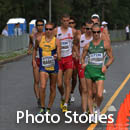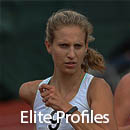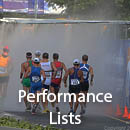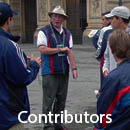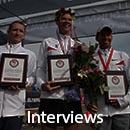JIM HEIRING
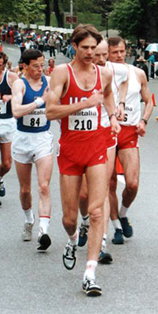

Birthday: November 4th, 1955
Current Residence : Kenosha, WI
Hometown: Kenosha, WI
College: University of Wisconsin, Parkside
PRS
Outdoors
20 km - 1:24:51
50 km - 4:03:34
Indoors
1 mile - 5:41.26
Jim Heiring was first exposed to race walking when he watched Larry Young win the bronze medal at the 1968 50K Olympic race walk. A few years later, as a high school , he decided to try race walking at the Junior Olympics. At this disappointing first attempt, Heiring was disqualified for disobeying the rules that differentiate race walking from running.
Luckily for Heiring, Mike DeWitt—in his pre-Coach DeWitt days—was nearby to teach Heiring the correct form. The combination of Heiring's natural talent and Dewitt's technical advice paid huge dividends. Heiring won the next race, the Junior Olympics Wisconsin State Championships, and continued on to the National Junior Olympic championships, where he finished 4th.
While race walking enthusiasts today associate the University of Wisconsin-Parkside, with Mike DeWitt, back then Bob Lawson coached the team. Lawson offered Heiring a scholarship, with the deal then pretty much the same as now: run cross-country, race walk during track season.
By 1976 Heiring was a college junior. He competed at the Olympic Trials, where time standards for qualification had yet to be established. The top three finishers at the trials made the team, and Heiring finished a close 5th. This achievement lead him to the epiphany, “I might be pretty good at this." He decided to dedicate himself to race walking full time.
Heiring's commitment paid off when during his senior year, he won both the Indoor and Outdoor NAIA championships. He graduated with an Art degree and felt he had to make a choice between art and athletics. Obviously, Heiring chose athletics.
With enough harsh Wisconsin winters under his belt, Heiring moved to California where the weather was more conducive to training. He worked part-time as a commercial artist while focusing on preparations for the 1980 Olympic Games. For the most part, Heiring trained alone. A few times a month, he met with Dan O'Connor for a weekend workout. Unfortunately, Heiring was hampered by injuries and became frustrated. With no coach and no formal development program, he diligently worked alone and overcame the adversity. The 1980 20K Olympic trials found Heiring and Marco Evoniuk walking together with two miles to go. The two purposely finished in a tie.
Unfortunately, the fate of our athletes was already determined before the race began. They all were beaten by opinions—opinions that lead to the U.S. boycotting the Olympics. Heiring views the lost Olympic opportunity as one of the biggest disappointments of his life.
After the Olympic Trials, Heiring spent a year working out with the Parkside athletes before moving to the Olympic Training Center at Colorado Springs. Race walking at the national level was taking a step in the right direction by establishing a resident athletes program. During this time, Martin Rudow coached Heiring over the phone and via mail while making frequent visits to Seattle.
Heiring’s training was timed perfectly for him to peak again at the Olympic Trials in 1984. Leading by a mile and a half at 10K, he was well on his way to winning his second trials when the knee problems that plagued his career flared up. He relinquished the lead, but not his long-awaited berth on the Olympic Team. He finished second.
In 1986 Heiring moved back to Wisconsin and became reacquainted with Mike DeWitt, who helped him extend his racing distance to 50K. Success followed him to this event as he walked a 4:03 in Rome at the 1987 World Championships.
When Heiring competed at his fourth 20K Olympic Trials, he decided he would just walk his own race. He walked as hard and fast as possible, holding his pace as long as he could. Finishing 4th, he ignored the murmurs he heard from the sidelines. But 3rd-place finisher Paul Schwartzberg was disqualified, making Heiring eligible for the Olympics once again.
As soon as he crossed the finish line at the 1988 Seoul Olympics, Heiring retired. He realized that continuing to race no longer made sense to him. While he walked faster than he had at the 1984 L.A. Games, he had finished 10 to 15 spots further back. Without any real hope of winning an Olympic medal, he decided to stop putting life on hold to simply participate on the team.
Heiring has since married, and he and his wife have two sons. When he reminisces about his career, the aspects he most enjoyed barely show up on the competitive radar. "Racing indoors was a blast. Madison Square Garden, with 20,000 people watching!" he recalls fondly. At one point, Heiring held Indoor World Records at the 1500M, 1-mile and 2-mile distances. It seems inconceivable now, but back then the sponsors were generous. The Indoor Grand Prix Circuit could net the top walker a good $20,000 in one year: a unique opportunity for race walkers to earn money.
1988
4th - 1:27:30
1987
10th - 1:31:34
1985
4th - 1:27:44
1984
2nd - 1:26:15
1983
1st - 1:24:51
1982
1st - 1:25:30
1981
3rd - 1:28:04
1980
2nd - 1:27:12
1979
3rd - 1:28:51
1978
7th - 1:34:50
1977
4th - 1:33:40
1976
5th - 1:36:58
1988
4th - 4:09:09
1987
3rd - 4:03:34
1983
4:07:20
1981
3rd - 4:15:29
1980
4th - 4:12:57
1979
4th - 4:17:47
1986
2 mile - 12:05.94
1985
2 mile - 12:07.5
1984
2 mile - 12:11.21
1982
2 mile - 12:24.82
1985
5K - 20:21
1984
15K - 1:03:07
1983
5K - 20:33.3
15K - 1:03:26
20K - 1:26:55
25K - 1:50:38
1982
2 hour - 15m 1596 yards
10K - 44:17.6
15K - 1:04:36
20K - 1:30:22
1981
10K - 45:07.6
20K - 1:30:47
1980
20K Olympic Trials - 1:27:12
1979
25K - 1:57:28
1978
30K - 2:30:50
20K Olympic Games
1988 - 38 th - 1:27:30 - Seoul, Korea
1984 - 23 rd - 1:30:20 - Los Angeles, USA
20K World Championships
1983 - 19 th - 1:25:55 - Helsinki, Japan
50K World Championships
1988 - 22 nd - 4:03:34 - Rome, Italy
1983 - DNF - Helsinki, Japan
20K Pan Am Games
1983 - 6 th - 1:34:47 – Caracas, Venezuela
20K World Cup
1983 - 16 th - 1:24:51 - Bergen, Norway
1981 - 22 nd - 1:30:39 - Valencia, Spain
1979 - 31 st - 1:28:51 - Eschborn, West Germany
1977 - 36 th - 1:33:40 - Milton Keynes, Great Brittan
50K World Cup
1987 - 29th - 4:08:15 - New York City, USA
